(CNN) — Astronomers using the Hubble Space Telescope have detected water molecules in the atmosphere of a small exoplanet 97 light-years away from Earth.
The planet, called GJ 9827d, is twice the diameter of Earth and the smallest exoplanet with a water vapor atmosphere, according to a new study.
Water is essential to life as we know it, but the planet is unlikely to support any life due to warmer temperatures that turn the water-rich atmosphere into burning steam.
Astronomers have yet to discover the true nature of this unusual world's atmosphere, but the revelation paves the way for new research as they seek to understand the origins of planets beyond our solar system.
The findings appear in a report published this Thursday Astrophysical Journal Letters.
“Water is a historic discovery on such a small planet,” Laura Kreidberg, study co-author and head of the Department of Exoplanet Atmospheric Physics at the Max Planck Institute for Astronomy in Heidelberg, Germany, said in a statement.
However, the planet reaches temperatures of 800 degrees Fahrenheit (427 degrees Celsius), making it a vaporous, inhospitable world as hot as Venus.
“This is the first time we have directly demonstrated through atmospheric detection that these planets with water-rich atmospheres can actually exist around other stars,” said Björn Bennek, a professor at the university's Trottier Institute for Exoplanet Research. University of New York, Montreal, in a report. “This is an important step in determining the distribution and diversity of atmospheres on rocky planets.”
Currently, the research team cannot say whether Hubble detected traces of water vapor in a bloated, hydrogen-rich atmosphere or whether the planet has a water-rich atmosphere because the host star GJ 9827d has evaporated its original hydrogen-helium atmosphere.
“Our observing program, led by principal investigator Ian Crossfield of the University of Kansas (Lawrence, Kansas), was designed with the goal of not only detecting molecules in the planet's atmosphere, but also looking for water vapor.” says Pierre-Alexis Roy, lead author of the study and a postdoctoral fellow at the Trottier Institute at the University of Montreal, in a statement. “Whether water vapor dominates or is a minor species in a hydrogen-dominated atmosphere, the results are exciting.”
A planetary puzzle
NASA's Kepler mission initially discovered the planet in 2017 when it orbited a red dwarf star in the constellation Pisces. The exoplanet orbits its host star every 6.2 days.
Astronomers have observed GJ 9827d during 11 trips, or three years of orbit, as the planet passes in front of its star. Starlight filtered through the planet's atmosphere helped astronomers measure the signature of water molecules.
“Until now we have not been able to directly detect the atmosphere of such a small planet. Now we are slowly entering this regime,” Benneck said. “Sometimes, when we study small planets, there must be a transition in these small worlds where there is no hydrogen, and they have atmospheres similar to Venus (carbon dioxide dominated).
Knowing better about the planet's atmosphere will help astronomers classify what kind of world GJ 9827d is. Currently, the team has two possible theories.
The planet may be a mini-Neptune with a hydrogen-rich atmosphere containing water vapor. If so, GJ 9827d may have formed much farther from its host star than its current location, meaning the planet was colder and water ice-like (more distant from planets like Neptune and Uranus. Our Solar System).
According to the researchers, as the planet got closer to its star and received more stellar radiation, the hydrogen heated up and escaped, or continued to escape.
Or GJ 9827d, astronomers suspect, could be a warmer version of Jupiter's icy moon Europa, which has an ocean beneath its thick icy crust. Benneke said the planet could be half water and half rock.
Searching for water in space
Water is one of the most common molecules found in the universe, and for years astronomers have included finding water as an important part of the search for life beyond Earth.
“Observing water is a gateway to looking at other things,” study co-author and astrophysicist Thomas Green of NASA's Ames Research Center in Silicon Valley, California, said in a statement. “This Hubble discovery opens the door to future studies of such planets by the James Webb Space Telescope. JWST can see more with additional infrared observations, including carbon-bearing molecules such as carbon monoxide, carbon dioxide and methane. A full profile of a planet's elements, including those it orbits. By comparing it with the star, we can understand how it was formed.”
Astronomers have already observed GJ 9827d with the Webb telescope to look for water and other types of molecules, and that data will be shared in the future.
“We're curious to see what that data reveals,” Kreidberg says. “Hopefully, we can now solve the water worlds problem once and for all.”





